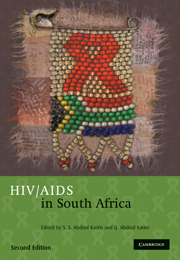Book contents
- Frontmatter
- Contents
- List of Contributors
- Foreword: Peter Piot
- Foreword: Nelson R Mandela
- Acknowledgements
- Section 1 Birth of a rapidly growing epidemic
- Section 2 The virus, the human host and their interactions
- Section 3 HIV risk factors and prevention strategiess
- Section 4 Focal groups for understanding the HIV epidemic
- Section 5 The impact of AIDS
- 21 Impact of AIDS – the health care burden
- 22 The impact of AIDS on the community
- 23 The impact on ethics
- 24 The economic impact of AIDS
- 25 AIDS-related mortality in South Africa
- 26 Picking up the pieces: the end of AIDS denialism and its aftermath
- Section 6 Treating HIV
- Section 7 What does the future hold?
- Index
22 - The impact of AIDS on the community
Published online by Cambridge University Press: 07 September 2011
- Frontmatter
- Contents
- List of Contributors
- Foreword: Peter Piot
- Foreword: Nelson R Mandela
- Acknowledgements
- Section 1 Birth of a rapidly growing epidemic
- Section 2 The virus, the human host and their interactions
- Section 3 HIV risk factors and prevention strategiess
- Section 4 Focal groups for understanding the HIV epidemic
- Section 5 The impact of AIDS
- 21 Impact of AIDS – the health care burden
- 22 The impact of AIDS on the community
- 23 The impact on ethics
- 24 The economic impact of AIDS
- 25 AIDS-related mortality in South Africa
- 26 Picking up the pieces: the end of AIDS denialism and its aftermath
- Section 6 Treating HIV
- Section 7 What does the future hold?
- Index
Summary
HIV IS HAVING A major impact on individuals and on community structures such as the family. Family has traditionally been the fundamental unit of any society but as the epidemic progresses this structure is being steadily eroded.
One of the most obvious changes has been in the increase in single-parent households. In South African society, women have previously often effectively been single parents as fathers have worked away from home. However, although this is still the case, ‘skipped generation’ households, headed by a grandmother, are increasingly common. The traditional absorption of orphans by the extended family is no longer possible, as already strained communities struggle to cope with the increasing burdens of hiv and aids.
These burdens are made worse by the stigma attached to the disease, which among other effects, prevents those affected from being able to grieve openly. The traditional rituals associated with death are also often no longer followed as whole communities deny the existence of hiv as an illness. However, the numbers of orphans resulting from aids-related deaths in South Africa are predicted to rise to over five million by 2014, making effective community response to the epidemic essential.
Responses encompass different levels of care for orphans, community involvement in prevention and awareness efforts and continued advocacy and support for social change.
The state has a responsibility, underpinned by the Constitution, to provide assistance in the form of social grants for varying levels of need.
- Type
- Chapter
- Information
- HIV/AIDS in South Africa , pp. 373 - 392Publisher: Cambridge University PressPrint publication year: 2010



